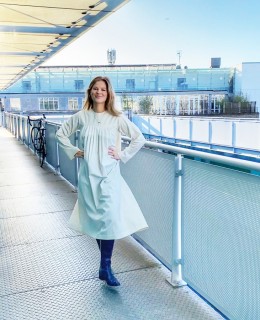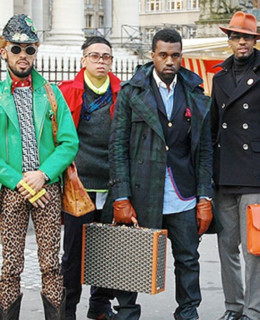Imagine your shirt being so natural that you can plant it once you’ve outgrown it and harvest a new one instead. Science Fiction? Nope. In nature there is no such thing as waste, why not be inspired by it? A new generation of “bioneers” is leading the way by creating biodegradable fabrics out of living bacteria, algae, yeast, animal cells and even fungi.
No one can deny the fashion industry’s huge environmental footprint: not only is it contributing to gigantic landfills all around the world, the speed and volume at which clothes are made and consumed nowadays require enormous energy and water use, cause harmful greenhouse gas emissions and pollute our planet’s oceans at an alarming rate. In a race against time -and against the infernal pace of fast fashion- industry insiders try to tackle the problem at its very roots: materials. They are looking for sustainable, animal- and environmentally friendly alternatives to the textiles that have dominated the industry for years, but however nice they may sound, not all these alternatives turn out to be that ecological.
Fake fur for instance, is actually made out of pure plastic, consisting of nylon, acryl and polyester, none of which is biodegradable, and releases toxic particles into nature with every wash. Furthermore, it turns to waste when we are done wearing it, in contrast to natural fur, that will eventually biodegrade. Same goes for certain types of imitation leather. I’m not saying we should all start wearing real fur and leather, just pointing out that “vegan” isn’t necessarily synonymous with “ecological”. Going even further down this road; did you know –absurd as it may sound- that plastic was introduced over a century ago as thé savior of the planet? John Wesley Hyatt developed the first synthetic polymer in 1869 as a substitute for ivory, as hunters could no longer provide its natural counterpart due to huge demands and a decreasing elephant population. Same went for whale bone (frequently used for corsets), tortoise shells, tusks and other hugely popular animal-derived materials. Plastic, in its later form, could be crafted into a variety of shapes and proved to be the perfect imitation. It was considered revolutionary, as for the first time mankind didn’t need to rely on natural resources and could casually produce whatever it needed without harming Mother Nature. The joke’s on us. And on said mother…
Furthermore, turning away from man-made textiles in favor of natural fibers isn’t the solution either. Commercial farming, necessary to meet the extent and pace of our fashion system, is extremely water and land extensive, upsets the natural order of things and releases a lot of toxines such as pesticides and dying products into nature. Take bamboo viscose for instance: although its environmental impact is little to none compared to traditional cotton, it still requires a high amount of chemicals to process it into garments. So even though its farming isn’t as damaging as cotton’s, you have to consider the total package.
What’s next in line for sustainable fashion? Recycling! Preventing fashion waste from ending up in landfills or combustion and re-entering it into the supply chain has a positive ecological impact, but we could even take it a step further: what if we skipped the journey to the garbage bin altogether?

What if garments were designed and produced, not only out of waste, but also with the specific aim of nèver turning into garbage? It’s the starting point for a small, but growing group of innovators who use living organisms in order to grow pieces of biodegradable textile in their labs. It’s an idea that has been brewing –quite literally- for a while now and one of its pioneers is British designer Suzanne Lee, founder of Biocouture, which creates clothing made from bacteria. In her 2011 Ted Talk Grow Your Own Clothes she illustrated how you can create imitation leather by growing bacteria cellulose in sugar liquid, which in her case was collected as a by-product at a local food plant. In 2017, Stella McCartney jumped on the bandwagon by going into partnership with Bolt Threads, a biotechnology expert that has since provided her with alternatives to wool, silk and cotton, created out of natural proteins.
In New York that very same year, Fashion Institute of Technology professor Theanne Schiros and her students amazed the jury of the prestigious Biodesign Challenge by harvesting a pair of baby moccasins out of bacteria, fungi and compostable waste: after having grown the bacteria into a mat of bio leather, they put it around a shoe-shaped mold and stitched it with fibers from discarded pineapple tops obtained at a local smoothie shop. They even produced dyes from avocado and carrot seeds. According to Team #Growapair, as they fashioned themselves, the shoes could be planted right back into the earth after use and provide new raw material for further creations afterwards. It echoes what Lee said in 2011, when she claimed her leather could be composted and thus disposed of “like your average vegetable peelings”.
Bioengineered fabrics offer a range of sustainable options for the fashion industry, besides using waste to reduce waste. Because many of the organisms involved can be grown to fit molds, and thus produce the exact right shape and amount of fabric needed, they create garments without generating excess material and leftovers, nor do they require factory assembly. Furthermore, they can be made from the waste stream of other industries, such as the food industry, which takes away the need for polluting farming. Forget about pesticides or invading large land areas, Lee didn’t need to spill one drop of water nor earth in her search for raw materials, as she based her production on sugar leftovers from a neighboring food processing plant. Does this process move fast enough for the fashion industry? Anyone having spent over a week in a college dorm will confirm it: nothing grows as fast as mold…
Another classic fast fashion issue is the dying process, which traditionally wastes and pollutes water on a frightening level: thousands of chemicals are either incorporated in the fabric, making it harmful for human skin, or spilled in the leftover water, in order to produce a lasting color. The solution would be to use naturally pigmented bacteria to dye bioengineered textiles, which is a non-toxic process that requires a considerable lesser amount of water.
Of course, as always, there is a catch. For now the use of bioengineered products has been confined to the realms of labs, science competitions and expensive, pioneering fashion houses such as Stella McCartney’s. Average Joe has probably never heard of it and would gasp in horror at the sight of its price tag. Insiders argue a widespread use will only be enabled by government subsidies and investments in both research ànd scaling. Moreover, not all developed fabrics have the right properties to be considered by the mainstream industry, nor to withstand wear and tear, although technology is constantly evolving. When Lee presented her work back in 2011, the big issue was that she couldn’t make it water-resistant, while nowadays Stella McCartney boasts waterproof fabrics. Also, if fast fashion is to persist, its materials should be incorporated into a circular economy too. Scalability is a major hurdle and cooperation across different fields and industries is the missing link. There needs to be a common breeding ground for all the research, projects, technologies and breakthroughs. Same goes for creating bridges between the fashion- and for instance the food industry to create fruitful collaborations, no pun intended, as well as linking the right research and manufacturers to labels and designers. Without any such thing, innovators will continue to work at small scale. Progress is made luckily and big platforms like Future Fabrics Expo, set up by The Sustainable Angle, Wearable Futures and Biocouture are striving to do just that.
Demonized as it may be, the fast fashion segment needs to get involved as well, as H&M showcases. Through its annual Global Change Award, it looks for ànd sponsors sustainable innovations, which may be tested out in its small-scale Conscious Collections, which in their turn are meant to test the scalability of new inventions. It makes for both triumphs and defeats. Polyester made out of recycled PET-bottles for instance, was a rare attraction a few years ago, but is now one of the key fabrics used by the company, also in its mainstream collections. Orange Fiber, a company that makes leather out of by-products of citrus juice production, won the price in 2016. It took a while and some perfectioning, but in 2019 the fabric was deemed ready to be tested in the Conscious line. The outcome is as much promising as it is disappointing: on the upside the resulting garments were beautiful, comfortable and much appreciated by the audience. On the downside, the H&M team couldn’t produce as many of it as it wanted because the citrus harvest hadn’t been as good as usual this year. The economical risk of relying on it for big-scale production would be too high and thus, says H&M Creative Advisor Anne-Sophie Johansson, the fabric will never be enough to provide the whole of H&M. It’s a shame, and it makes one scream at the principles of mass-production and -consumption, which is yet another war to fight. Bioneers are not giving up though, and everywhere around the world fashionable geeks are boiling and moulding mushrooms, wine, vegetable peelings and pineapple fibers in the hope of beating the system.
As I said, something’s brewing and the result will be tasty!
PS: Check out Suzanne Lee’s original Ted Talk here to grasp the beginnings of biotech fabrics, it’s fascinating:




